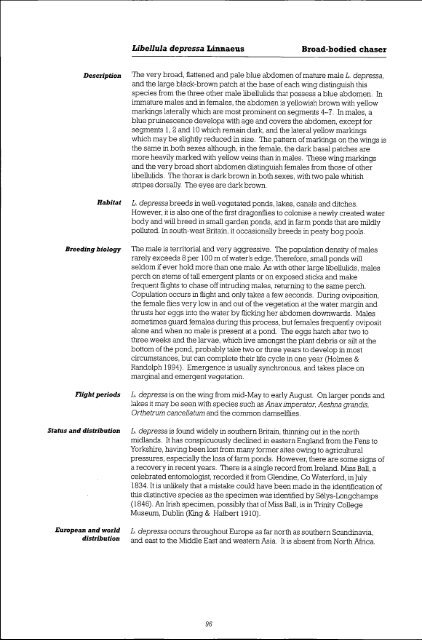Download - NERC Open Research Archive - Natural Environment ...
Download - NERC Open Research Archive - Natural Environment ...
Download - NERC Open Research Archive - Natural Environment ...
Create successful ePaper yourself
Turn your PDF publications into a flip-book with our unique Google optimized e-Paper software.
Libellula depressa Linnaeus Broad-bodied chaser<br />
Description The very broad, flattened and pale blue abdomen of mature male L. depressa,<br />
and the large black-brown patch at the base of each wing distinguish this<br />
species from the three other male libellulids that possess a blue abdomen. In<br />
immature males and in females, the abdomen is yellowish brown with yellow<br />
markings laterally which are most prominent on segments 4-7. In males, a<br />
blue pruinescence develops with age and covers the abdomen, except for<br />
segments 1, 2 and 10 which remain dark, and the lateral yellow markings<br />
which may be slightly reduced in size. The pattern of markings on the wings is<br />
the same in both sexes although, in the female, the dark basal patches are<br />
more heavily marked with yellow veins than in males. These wing markings<br />
and the very broad short abdomen distinguish females from those of other<br />
libellulids. The thorax is dark brown in both sexes, with two pale whitish<br />
stripes dorsally. The eyes are dark brown.<br />
Habitat L. depressa breeds in well-vegetated ponds, lakes, canals and ditches.<br />
However, it is also one of the first dragonflies to colonise a newly created water<br />
body and will breed in small garden ponds, and in farm ponds that are mildly<br />
polluted. In south-west Britain, it occasionally breeds in peaty bog pools.<br />
Breeding biology The male is territorial and very aggressive. The population density of males<br />
rarely exceeds 8 per 100 m of water's edge. Therefore, small ponds will<br />
seldom if ever hold more than one male. As with other large libellulids, males<br />
perch on stems of tall emergent plants or on exposed sticks and make<br />
frequent flights to chase off intruding males, returning to the same perch.<br />
Copulation occurs in flight and only takes a few seconds. During oviposition,<br />
the female flies very low in and out of the vegetation at the water margin and<br />
thrusts her eggs into the water by flicking her abdomen downwards. Males<br />
sometimes guard females during this process, but females frequently oviposit<br />
alone and when no male is present at a pond. The eggs hatch after two to<br />
three weeks and the larvae, which live amongst the plant debris or silt at the<br />
bottom of the pond, probably take two or three years to develop in most<br />
circumstances, but can complete their life cycle in one year (Holmes &<br />
Randolph 1994). Emergence is usually synchronous, and takes place on<br />
marginal and emergent vegetation.<br />
Flight periods L. depressa is on the wing from mid-May to early August. On larger ponds and<br />
Status and distribution<br />
European and world<br />
distribution<br />
lakes it may be seen with species such as Anax imperator, Aeshna grandis,<br />
Orthetrurn cancellatum and the common damselllies.<br />
L. depressa is found widely in southern Britain, thinning out in the north<br />
midlands. It has conspicuously declined in eastern England from the Fens to<br />
Yorkshire, having been lost from many former sites owing to agricultural<br />
pressures, especially the loss of farm ponds. However, there are some signs of<br />
a recovery in recent years. There is a single record from Ireland. Miss Ball, a<br />
celebrated entomologist, recorded it from Glendine, Co Waterford, in July<br />
1834. It is unlikely that a mistake could have been made in the identification of<br />
this distinctive species as the specimen was identified by Sélys-Longchamps<br />
(1846). An Irish specimen, possibly that of Miss Ball, is in Trinity College<br />
Museum, Dublin (King & Halbert 1910).<br />
L. depressa occurs throughout Europe as far north as southern Scandinavia,<br />
and east to the Middle East and western Asia. It is absent from North Africa.<br />
96

















